Equipment Insight -- Aerial lifts
New models improve safety, efficiency and productivity, according to insights from aerial equipment experts at Custome Equipment, Genie, JLG, Sinoboom North America, Ruthmann Reachmaster, JCB, and All Access Equipment.
The new generation of aerial lifts go well beyond the intent of the ANSI A92 regulation.
Models that are compliant with these relatively new MEWP regulations have been rethought with end users in mind, addressing pain points and information-gathering systems that aim to improve the units’ flexibility, productivity and ROI.
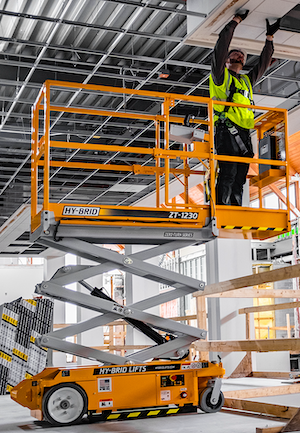 |
|
Hy-Brid Lifts debuted an all-electric scissor lift last fall that uses an electric actuator for lifting functions, eliminating the need for hydraulics. |
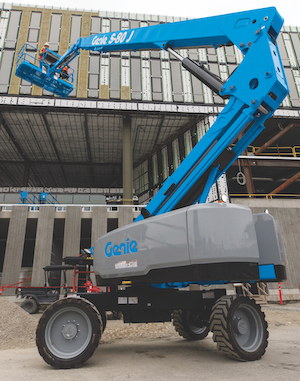 |
|
For a rental center, increasing demand and rental return on invested capital (rROIC) comes down to making sure rental centers have the right equipment for their customers’ job site needs, and then making sure that equipment is ready to rent when their customer wants it. |
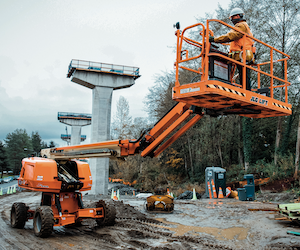 |
| Self-leveling technology on the new JLG 670SJ model allows the machine to continuously and automatically self-level on slopes up to 10 degrees at full height. |
 |
| Manitou’s EasyManager makes it easy to complete preventive maintenance, improve machine security, increase uptime and provide better customer service. |
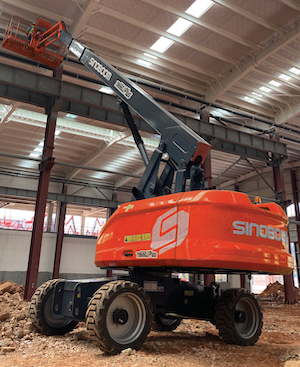 |
| Operator preference and overall comfort when operating MEWPs are important, which can lead to specific brand loyalty. |
 |
|
Compact tracked lifts have been operating under many |
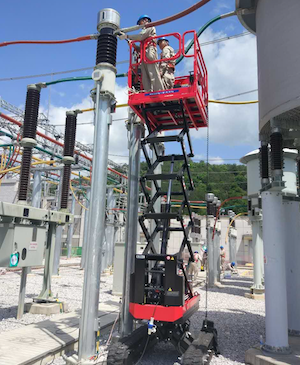 |
| Rental centers must identify the rental prospects and/or applications and make sure that the sales force is properly aligned. |
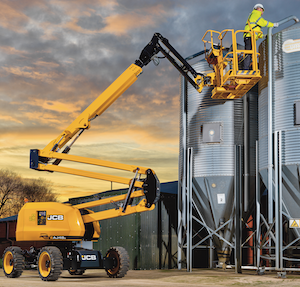 |
| The JCB AJ48D diesel articulated boom, with a lift height of 48 feet 4 inches and load capacity of 551 pounds, equips operators to maximize productivity in challenging outdoor environments. |
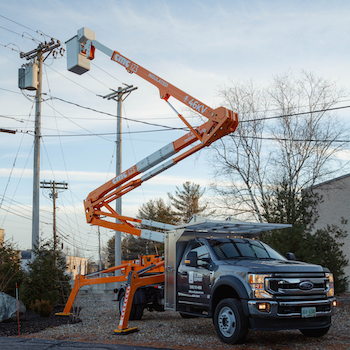 |
| The CMC 46kV tracked lift is a three-in-one unit. It can be used on its tracks indoors or outdoors or as a truck-mounted unit. It is insulated and rated for work on lines up to 46 kV power lines. |
New models are increasingly leveraging hybrid or all-electric drive systems that offer emissions-free operation and simpler maintenance procedures. Others are helping end users go into difficult applications, getting workers closer to work at height.
Pro Contractor Rentals asked aerial lift experts to share their aerial lift insights and how rental centers be more profitable with them.
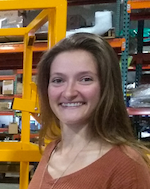 |
| Marketing Associate JENNIFER PARKER Custom Equipment |
All-electric units gain popularity
The access industry is shifting toward more efficient mobile elevating work platforms. Industry watchers are seeing an increase in the number of end users requesting electrically powered machines to reduce hydraulic leaks, potential jobsite damage and subsequent rework costs. While all self-propelled Hy-Brid Lifts already feature electric drives and steering, Hy-Brid Lifts is taking electrification to the next level.
Hy-Brid Lifts debuted an all-electric scissor lift last fall that uses an electric actuator for lifting functions, eliminating the need for hydraulics. This compact scissor lift has zero hydraulics, zero leak potential, zero emissions and produces less noise than traditional machines, making it ideal for indoor applications. Because the all-electric lift has no fluids to maintain, operators can spend less time maintaining the equipment and more time at height getting work done.
The major consideration for rental houses adding new machines to their fleet is ROI. Each machine’s return on investment depends on how much run time that machine gets. If the lift is dogged by high maintenance, faulty wiring or hydraulic leaks, it will spend more time in the shop than out in the field earning revenue. Hy-Brid Lifts are designed to be as maintenance-free as possible to maximize their uptime and rental center ROI.
Another consideration is understanding users’ needs. Are they requesting lifts with best-in-class maneuverability to navigate complex job sites? Do they have specific floor load requirements to work around? Are they interested in reducing time constraints by eliminating the need for folding rails? Do they want lifts with higher platform capacities to bring more materials and tools up at once? These are all questions to ask customers to help decide which scissor lift models to consider adding to the rental center fleet.
Sometimes looks can be deceiving, but more often than not, old machines require more maintenance than newer models. This translates to increased maintenance costs and more time spent in the shop, meaning that older machines can spend less time bringing in revenue. Keeping an updated fleet may be more expensive initially but knowing when to retire aged machines can pay off in the long run.
Requesting new machine demos and trial runs are great ways to become familiar with current models and get real customer feedback before placing an order.
Having a more customer-centric business model may also increase demand and machine ROI. Ask questions that guide customers to find the best model for their needs instead of assigning the first product that’s available. While this strategy may be difficult to implement, increasing customer knowledge of your product selection can boost customer satisfaction, retention and ultimately, your ROI. <
Product Managers
ZACH GILMOR and SEAN LARIN
Genie
Focus on rental return on investment
One of the biggest trends in the industry, and an area where there is great emphasis and progress, is electrification. Even though hybrid and electric technologies have been around for a while now, the pace of adoption is continuing to accelerate.
This is due to the convergence of several key factors. The first is global job site regulations that are becoming increasingly stringent. As this occurs, we’re seeing greater demand for cleaner, quieter equipment. At the same time, as technology advances, electrified equipment is offering better and more efficient performance. Finally, the cost of the technology is continuing to come down.
So, thinking about electrification, the convergence of these factors – performance, cost and demand – is a great example of an area where advances in design and technology are answering customers’ needs for equipment that offers both superior performance and overall value.
A great example of this is Genie’s AC E-Drive scissor lifts. E-Drive, which is available across the Genie lineup of GS slab scissor lifts and GS-1932 and GS-1432 micro scissor lifts, provides more runtime per charge and delivers industry-leading job site performance while lowering the total cost of ownership.
For a rental center, increasing demand and rental return on invested capital (rROIC) comes down to making sure rental centers have the right equipment for their customer’s job site needs, and then making sure that equipment is ready to rent when the customer wants it.
One way to do this is by investing in quality, versatile equipment that can meet the needs of multiple applications. Genie FE hybrid booms, for example, deliver the same rugged, 4x4 performance as a diesel boom, even on challenging outdoor terrain. At the same time, the very same FE boom can be rented for indoor work, or to customers whose job sites have stringent regulations related to noise and/or emissions. In addition to the ability to work indoors and outdoors, Genie FE booms can work more than a week on a single tank of fuel and can deliver a full day’s performance on a single battery charge when run in full electric mode. Additionally, by charging the batteries while the boom works, the boom’s intelligent control system can nearly eliminate the downtime caused by plug-in charging. This combination of versatility and performance captures more demand and allows the rental center to better serve its customers.
Another way for a rental center to maximize its rROIC is to invest in equipment with a lower total cost of ownership. This is one reason Genie offers the S-60 J and S-80 J boom lifts. The design of Genie J series booms has been optimized to speed inspection, maintenance and repairs by reducing the overall number of inspection points and wearable components. This reduces the time and expense of maintenance, as well as downtime, which means a lower total cost of ownership for the rental center and a greater return on their investment. At the same time, J series booms are built for real-world job site performance. Their leading unrestricted platform capacity of 660 pounds and standard six-foot jib make them well-suited for many work-at-height tasks, including general construction, maintenance, inspections and painting.
Rental centers can increase demand and ROI by offering optional accessories that can increase job site productivity for specific applications and needs. This is especially true when the accessories can be used on multiple units within a single fleet, allowing the rental center to mix and match lifts and accessories to offer their customer the best fit to maximize their productivity safely. This need to offer versatility for both equipment and accessories is something Genie engineers understand well. It drives accessory design – the lift tools panel cradle for boom lifts, for example can be used across the Genie product line. The panel cradle, which can be used for lifting drywall, glass panes, plywood and other material that comes in panels up to 250 pounds, can be used with a variety of Genie Z articulating booms and S telescopic booms, including Xtra Capacity (XC) models.
Finally, and maybe most important for a rental center, is making sure their equipment is ready to rent when a rental opportunity arises. Because if it’s not, their customer might choose to rent from a competitor. This is why uptime is so important. It’s also why Genie is focused on designing and manufacturing quality equipment and offering quality parts, service and support.
 |
| Director of Marketing JENNIFER STIANSEN JLG |
Conquering uneven terrain
While JLG is consistently watching trends, the JLG development team is also actively watching how customers are using aerial lift equipment. The pain points the teams observe directly drive the JLG innovation process, which has moved from a focus on incremental product changes to transformational innovation to provide additional safety and productivity, resulting in features that offer new revenue streams for rental centers.
For example, engineers are advancing ground-level technologies to improve operator comfort and safety at height. Over the years, the researchers have observed that working on uneven terrain is a common job site challenge. Some of JLG’s most recent product development efforts on scissor lifts and boom lifts focus on offering solutions that help users work more confidently in these situations.
For example, the self-leveling technology on the 670SJ boom lift allows the machine to continuously and automatically level on slopes up to 10-degrees at full height. This eliminates the cumbersome and time-consuming need to grade the work area or crib the machine, allowing the user to get closer to the work area quicker.
On JLG scissor lifts, new RT/ERT models feature LiftSense, a standard feature that shows an operator the maximum height he or she can achieve before elevating based on side-to-side and front-to-back tilt, as well as the current capacity in the platform, which removes the guesswork that often results in having to descend and try again. Additionally, QuickLevel Advanced on RT scissor models automatically levels the machine on side slopes up to 4.5 degrees, while still allowing operators to drive at full height under certain conditions.
All of these ground-level features deliver tangible value to customers through improved onsite efficiencies and safety enhancements, while eliminating customer pain points such as:
- Constant repositioning
- Additional job site preparation, including leveling the ground
- Employing a bigger machine with further reach to access the work area from a level spot beyond where they’d ideally like to place the machine
- Using multiple machines
- Cribbing the machine on a localized platform to attain a level work surface
- Shoring up the ground or stone leveling a raceway to attain a level work surface
JLG engineering teams also continue to focus on the continuous evolution of equipment through innovative integrated technologies. The teams are dedicated to developing equipment solutions and applications that provide valuable data to facilitate business growth and advance job sites through sophisticated, yet simple-to-use technologies that seamlessly integrate with JLG machines, and in some cases, beyond the JLG product portfolio.
Some examples of this in recent JLG introductions include:
- JLG Mobile Control offers remote control on select models of scissor lifts through a mobile phone and the JLG Mobile Control app. Mobile Control allows the user to guide the stowed scissor lift from a distance with his or her phone, tether-free from the machine. This allows them to maneuver around obstacles, position it into areas with low clearance and load or unload it from a truck without the need for an operator in the platform or walking next to the machine.
- JLG’s downloadable Augmented Reality app has five modules including machine visualization, kit visualization, operational guidance, a decal viewer and inspection assistance. The visualization tools allow the user to choose the right equipment and/or accessory for the job by placing and moving a virtual machine or accessory onto a machine in an actual work environment. The operational guidance and decal viewer help users understand the machine controls and decals in his or her language, while the inspection assistant provides historical inspection data specific to the machine.
- JLG’s new Advanced Battery Monitoring system provides concise, actionable data that fleet managers can use to ensure fewer worksite interruptions and improve project completion times. The new system, designed for electric scissors and boom lifts, analyzes the machine’s battery charge and usage while providing superior diagnostic information on the battery and charger system. Components include a new Smart Charger, which logs the charge history and details on the machine controller, and a Mobile Control hardware module that provides wireless connectivity and interaction, allowing the user to access the data with a handheld analyzer tool or through the JLG Mobile Control app.
This just scratches the surface of what our customers are asking for, and we continue to look for ways to improve and innovate JLG digital offerings. The sky is the limit for expanding the use of these technologies to advance the connected job sites of today and the smart cities of the future.
JLG’s rental channel partners and end-user customers tend to have a wish list that can vary by region, by fleet makeup and by the type of work they complete. Despite regional differences, there are common themes. Presently, there is a large focus on enabling equipment users to do more with less, in tighter spaces, under stringent time and budget demands in a manner that is minimally disruptive to the environment. Technology and the speed it is advancing plays a huge role in this.
For example, JLG equipment developers are seeing an increase in requests for sensor technology, cameras and alert systems. JLG’s SkySense, an enhanced detection system, is one of JLG’s newer solutions for this need. It uses strategically placed object detection sensors to provide operators an added level of awareness of their immediate surroundings. The sensors establish warning zones and stop distances in the machine’s direction of motion. As the machine approaches the zone limits, audible alerts notify the operator, helping protect people and property.
While technology creates a buzz in the media, the physical product itself, as well as parts and service support, remain as important as ever. Rental centers need to keep in mind that with these more technologically advanced features, when paired with a high level of after-sale support and service, will deliver a comprehensive offering to their customers. An appropriate combination of physical machine enhancements and digital connectivity are key to providing owners and operators with the greatest long-term value.
The best way for rental centers to increase demand and/or ROI for the aerial equipment fleet is to continually invest in these new technologies and help their customers integrate them into their everyday operations. Embracing new technologies, despite the learning curve, will help accelerate adoption, which in turn will make new technologies more affordable. This is happening in everyday life; we are increasingly embracing connected technology such as smart speakers, watches, refrigerators, thermostats, doorbells, lights, and more. Automobiles are mobile computers, collecting and sharing streams of data.
The more people become familiar with technology features and the productivity benefits gained from them in their personal lives, the easier it will be to incorporating similar connectivity on the job site.
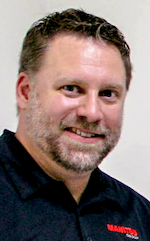 |
| Product Marketing & Training Manager BRIAN RABE Manitou |
Electric models debut in North America
Manitou has incorporated new models and features to its aerial lifts available in North America. Their product line now consists of three electric machines: the VJR 26, AETJ 43 and AETJ 49. Most models also incorporate Manitou’s EasyManager telematics software that includes machine location detection, hours and diagnostic data to stay in tune with the health of the machine.
Rental centers need to think about these points when contemplating on bringing new aerial lift models into their rental fleets:
- Ensure the machine has a suitable platform height and capacity according to their needs.
- It should be easy to operate with an intuitive control panel.
- Ease of machine transport. Make sure the dimensions of the unit and base weight match hauling capacities for what the rental center has available.
- A machine that is easy to service.
- On-board diagnostic tools that help maintain the machine, which is available on Manitou MEWPs.
It’s also valuable to work with a trusted manufacturer or dealer that has strong customer support and parts availability. It’s important to also look beyond the sticker price and consider the total cost of ownership and potential resale value.
Rental centers can increase demand or increase ROI with these units by making sure the units are maintained routinely. This ensures safety and smooth operation of the machine. Some items that should not be overlooked include greasing the axles and steering joints to prevent premature or excessive wear.
Connectivity telematics software can help increase model demand and increase ROI. Manitou’s EasyManager is a web portal and mobile app that gives the owner actionable data at his or her fingertips to help with the day-to-day management of their operations.
This feature makes it easy for the owner to complete preventive maintenance, improve machine security, increase uptime and provide better customer service. This allows the customer to concentrate on his or her core business and lets the owner or rental company better manage the life cycle of each machine.<
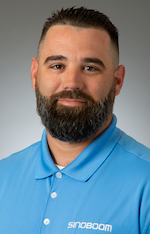 |
| Field Service/ Training Manager BRYAN LEVEILLE Sinoboom North America |
Advances in electric power
We continue to see advances in battery technology and the move away from diesel power in select mobile elevated work platforms (MEWPs). We’ve seen this trend occurring for some time in Europe for the preference of environmentally friendly electric booms and scissors and North America is following a similar trend.
What this means for customers is as machine and component technology advance, the focus will be on more efficient batteries with longer run times. For example, Sinoboom scissor lifts come standard with maintenance-free Discover batteries that are more efficiently discharged and recharged in comparison to traditional lead-acid batteries. Since battery replacement is one of the most significant costs related to maintenance, new technology in battery monitoring and telematics gives customers more insight to manage their charging habits.
When bringing new MEWPs into a rental fleet, machine operation and design are most important because of the different operator controls and machine configurations in the MEWP market. Operator preference and overall comfort when operating MEWPs are important, which can lead to specific brand loyalty. Sinoboom booms are known for their smooth operation due to the Rexroth controls combined with Hall effect joysticks, which allows operators to feel more secure in the platform.
Also important is taking into consideration the relatively recent ANSI A92 changes. Although education for ANSI changes has been ongoing, the complexity of the changes can be confusing and rental centers need to understand how the changes affected MEWP manufacturers product designs and offerings. For example, there are now limitations for outdoor use because of wind safety concerns. Sinoboom models have designed its ANSI-compliant scissor lifts for indoor and outdoor use so operators can easily switch between indoor and outdoor applications. Rental centers won’t need to be concerned if their scissor unit is being incorrectly used indoors or outdoors.
Minimizing maintenance costs can greatly increase your ROI and manufacturers have contributed to this through technology advances. For example, Sinoboom boom lifts feature a 7-inch LCD display that provides live data for quicker equipment diagnosis and decreased equipment downtime. No external tool is needed to connect to the electronic control unit (ECU) for the rental houses to make a diagnosis. Multiple data points allow technicians to diagnose equipment issues remotely and avoid an expensive technician dispatch to the job site.
Another example is Sinoboom scissor lifts have self-lubricating bushings and maintenance-free batteries. While these items are still regularly inspected, it takes away some of the day-to-day responsibility. It also helps prevent user-induced failures, such as lack of grease or low battery water levels. All of this contributes to more fleet uptime and overall better ROI.
 |
| Aerial Specialist ALAIN PARE´ Up Equip |
Training key to safe, successful tracked lift operation
The big difference with compact tracked lifts is that they are still a niche product and therefore don’t fit in the immediate scope of most rental houses that are heavily competing with “me-too” items. They don’t have time to look at the bigger scope and see the opportunities offered by compact aerial lifts to set themselves apart.
Apart from a few small-scale attempts, the compact tracked lifts have been operating under many rental operations’ radars. Bringing compact aerial lifts into a rental operation takes a willingness to invest and learn about compact tracked lifts. They are different than all the other equipment they rent. They will need to understand its operation because most new customers will call saying, “Your unit is not working.” Almost all the of these calls can be of handled over the phone because it’s almost always an operator problem.
Current culture is to drop units on job sites and let customers figure out operation. It’s a common practice and very true for me-too units but it won’t work for niche equipment such as compact aerial lifts. Each delivery should be done with operators present so the delivery person can take between 30 minutes to an hour explaining how to use the unit properly.
This is important because the main reason why the end user needs this type of equipment is because nothing else will do, aside from scaffolds. It is not the same as other equipment; its operation needs to be learned and understood.
Specialization comes at a cost and customers who need it will gladly pay for it. On average, a delivery including operator familiarization will be charged four to six times the price charged for standard equipment of the same size.
In the compact lift market niche, success comes to those who are patient and are building something. The ROI of compact lifts will not show up immediately. If you are expecting a quick ROI, move on.
On the other hand, if you’re ready to work hard, learn, share the knowledge and ultimately establish yourself as the alternative to scaffolds and build a reputation, this adventure is for you.
The best strategy is to support customers who tell you about their specific needs. This is a good opportunity to visit the job site, take measurements to ensure the compact tracked lift can get in and the chosen model will fit their needs. You become a consultant for a tailored solution, not another price for some highly price-competitive stock.
For example, at the request of an electrical contractor, Up Equip representatives walked a job in a museum to measure and arrange delivery of a compact Easy Lift 70-36AJ model for a few days of rental. After a meeting on the site, the managers of the museum learned about the lift and found many other applications for the unit once it was inside. From a single visit for a potential of one-week rental at $2,500 plus transportation, this turned into a 4-month rental.
With compact tracked lifts, the adage “we know when it leaves the yard, we do not know when it comes back” applies completely. For Up Equip models, 90 percent of rentals and re-rentals end up being extended well beyond the original established period.
The learning curve for compact aerial lift operation is between 2 to 6 weeks, operating it all day every day. Now imagine a customer that rents this unit for a few days to complete a job. He or she will likely have no idea on how to get it to do what needs to be done. Even with one hour of training, most people retain 15 percent of what has been shared, so expect the follow-up calls for assistance.
There are now more units in the market with everyone making claims. The market still doesn’t understand these. Easy Lift is by far the simplest brand, the safest and the one that will bring your rental staff the most confidence. The effective ROI on such a unit is between 2 to 3 days per month out on rental. That pays for the lift’s monthly payments; the rest is gravy. Once established, it’s likely that rental centers will miss rental opportunities because it is already out on rent.
The ROI will depend on utilization rate and the way your company manages depreciation and interest. Follow through this conservative and even pessimistic calculation; it does not consider any short-term rentals that are more profitable than long term. If the project is still profitable, you know you’re investing in the right product.
First, an Easy Lift 70-36AJ compact tracked lifts cost around $100,000. If you depreciate your equipment on 60 months (most do 120 months), your monthly cost is $1,666 plus interest plus maintenance (approximately 2 percent of acquisition cost/year including annual inspection).
Second, sum this up with exaggerated cost calculations. Monthly depreciation $1,666; exaggerated interest $250, exaggerated maintenance fee $400 for a total monthly cost of $2,340 x 12 months equals $27,792.
Depending on the area and demand, this model rents for $7,000 to $9,000 a month; then divide now by the lowest rental rate at $7,000 and you come up with 3.97X! Does any me-too equipment come even close?
The big question is whether a rental center can achieve this point of equilibrium at 33 percent utilization rate. If your answer is yes, you will cover your costs and everything else will pay off. Once your market knows that you have this type of specialized equipment and can help them with their specific need, the utilization rate typically goes up to 70 or 80 percent.
If your depreciation term is longer, your interest costs are lower and you perform standard maintenance, this ratio could drop to less than 2.0X and a point of equilibrium to +/-16 percent of minimum utilization rate to reach. There is no short answer to this, nor is there a short-term success. It comes with patience, work and experience.<
 |
|
President/CEO |
Be prepared for new model capabilities
Extensive use of CANBUS-based control systems allows for more safety features than ever before. These systems monitor a great number of movements and operations and can prevent accidents by stopping the unit ahead of an immediate danger such as overloading or not setting the unit up in a correct and safe manner.
A second feature that is developed on the back of this system is the telematic service modules and/or functions, which allow the manufacturer of the unit to troubleshoot from a distance via the internet or a SIM card on the unit. This can reduce or prevent expensive on-site service calls as well as helps reduce customer downtime.
When introducing new types of aerial lift models, it is very important that rental companies prepare from an operational as well as sales side ahead of time. The ability to provide technical backup and support is critical to any product that a rental company rents. When it comes to aerial lifts, the stakes are high as it is not only a question about the unit working, but having it work safely because it will be lifting people into the air.
Depending on the fleet size, some rental companies are more exposed to different technology than others. If the rental center’s fleet is based on mainstream products and it ventures into some of the newer technology equipment, the rental team must be aware of the differences and the need to plan for the technical training prior to launching a new type of aerial lift.
The same can be said about the sales side and ROI. The old classic line that nothing sells itself is still valid here and if your company has decided to enter a new aerial lift category, don’t take it for granted that your existing customer base is enough to carry it. Rental centers must identify the rental prospects and/or applications and make sure that the sales force is properly aligned. Often, the manufacturer and/or distributor will offer sales training programs that can become a vital tool to rental companies.
Rental centers can increase demand and ROI with two simple words: product awareness. It is vital that a rental company does not take for granted that customers know what equipment is in its fleet. To optimize demand, utilization and ROI, make sure your customers know about a new aerial lift coming into the fleet. It includes social media exposure, advertising and general exposure in the markets it serves. It takes efforts to focus on niche applications and it often pays off in the long term.
Another tool is demonstrations. While most customers may know what a boom or scissor lift is, they may not know what a compact lift is or can do. Be proactive and prepared to do demos in the initial stage of taking on a new aerial lift product.
Finally, many of the niche-oriented aerial lift categories are more directed to maintenance than construction. This means repeat business opportunities, so developing programs where customers get time slots per year for scheduled maintenance or seasonal use can increase ROI and utilization.
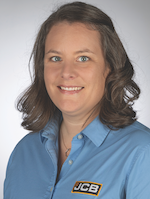 |
| Senior Product Manager, Material Handling REBECCA YATES JCB |
Match new models to job site demands
There are many innovative aerial lift solutions on the market when it comes to power source – electric, hybrid, dual fuel – that are providing greater job site versatility. JCB’s Access lineup includes a full range of electric scissor lifts that are extremely well-suited to various indoor or outdoor applications. In addition, the JCB AJ48D diesel articulated boom, with a lift height of 48 feet 4 inches and load capacity of 551 pounds, equips operators to maximize productivity in the most challenging outdoor environments.
JCB Access solutions are also designed to provide an unprecedented amount of feedback on machine performance and health, helping operators achieve optimal output as well as plan service and maintenance for improved uptime.
When expanding a rental center’s lift access fleet, consider the wide range of applications and unique job site needs new models may offer. Some aerial lifts. Make sure your fleet has all bases covered – articulated and straight boom models, a variety of lift heights and more – so that you’re prepared to meet customer demand.
Determine if there are specific options that are essential for increased productivity. Do customers need lights for after-hours jobs or power access built into the platform to run electric tools? Being able to identify common challenges will help rental centers stock their fleets with the right solutions.
Rental centers can increase demand and ROI with aerial lifts by providing ample training and support to ensure operators are using an aerial lift properly. This helps customers improve efficiency on the job site and get better returns from their rental equipment.
It’s important to perform all recommended preventive maintenance measures on an MEWP. JCB’s LiveLink telematics give fleet owners greater visibility into machine health and needed maintenance. Utilizing innovative telematics can help rental centers ensure equipment performs optimally in each rental application as well as extend its productivity over the long haul.
 |
| Founder LENNY POLONSKI All Access Equipment |
New models safer, easier to operate
The world is changing. It is very important for companies to keep up with changes for many safety reasons, including financial health reasons.
Today, more safety features, automation, user-friendly controls and ease of maintenance are advancing on tracked aerial platforms. Features such as automatic self-leveling, wireless radio remote control and automatic turret centering help automate and ease operation and take out the mystery of operating a tracked aerial lift.
The most important detail today is the emphasis on simplicity and greater safety, which translates into a safer work environment and less liability for users, companies and/or rental stores.
It is too late to think about safety after an accident has happened. Accidents can be devastating for the user, contractors and rental stores, and that’s why All Access Equipment recently came out with the CMC 46Kv, an insulated lift, rated up to 46Kv.
This new lift is three lifts in one. It is capable of working indoors or outdoors as a self-propelled lift with the capability of entering a 36-inch gate; or it can used as a truck-mounted lift. It provides the best return on investment while providing the most advanced safety features available.
When considering bringing new aerial lift models into their rental fleets, rental centers need to consider reliability and customer service as well as ease of operation and greater safety.
All Access Equipment models are delivered with “How To” operation video playlists as well as quick guides and more so rental centers can share these with their customers.
Reliability and customer service are also important factors. All Access Equipment’s CMC lifts are easy to maintain, reliable and backed up by a technical phone support team ready to answer your call when a question or problem arises.
There are many moving parts when considering adding any equipment to a rental fleet. Rental stores definitely need to give deep thought to remain competitive and provide the right equipment and position themselves for success in the future, so as not to be saddled with old unrentable and obsolete equipment, which simply become expensive paperweights in the parking lot.
It is time to invest in the next generation lifts that are easier to operate, are substantially safer and provide the ROI that every rental store needs.
To increase demand and in return increase ROI with tracked aerial lifts, rental centers need to promote and highlight the versatile benefits of renting or leasing an insulated tracked aerial lift.
While rental centers and their customers are accustomed to traditional scissor lifts and boom lifts, with their more advanced capabilities, safety and versatility, a tracked aerial lift might just be exactly what they need, but just are unfamiliar with it.
This article originally appeared in the March-April 2022 issue of Pro Contractor Rentals magazine. ©2022 Urbain Communications LLC. All rights reserved.








